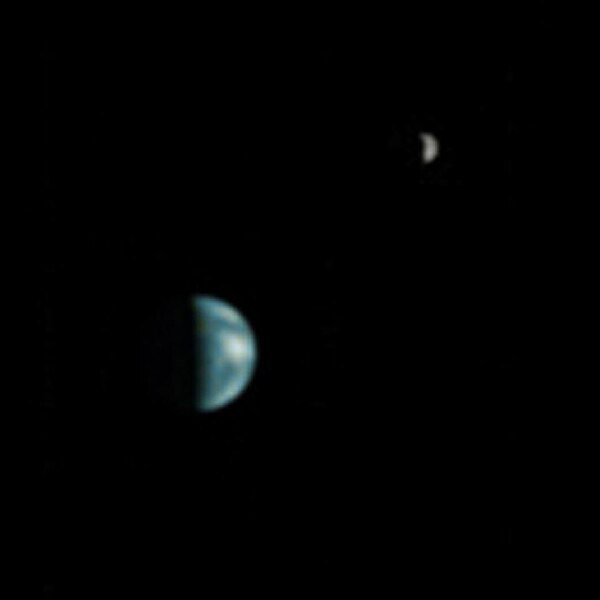Fitxer:Earth and Moon from Mars PIA04531.jpg
Aparença

Mida d'aquesta previsualització: 600 × 600 píxels. Altres resolucions: 240 × 240 píxels | 480 × 480 píxels | 961 × 961 píxels.
Fitxer original (961 × 961 píxels, mida del fitxer: 17 Ko, tipus MIME: image/jpeg)
Historial del fitxer
Cliqueu una data/hora per veure el fitxer tal com era aleshores.
| Data/hora | Miniatura | Dimensions | Usuari/a | Comentari | |
|---|---|---|---|---|---|
| actual | 15:07, 11 jul 2005 |  | 961 × 961 (17 Ko) | Complex01 | Courtesy NASA/JPL/Malin Space Science Systems [http://www.jpl.nasa.gov/images/policy/index.cfm] [http://www.msss.com/moc_gallery/policy.html] Image of Earth and Moon, taken by the Mars Orbiter Camera of Mars Global Surveyor on May 8 [[200 |
Ús del fitxer
La pàgina següent utilitza aquest fitxer:
Ús global del fitxer
Utilització d'aquest fitxer en altres wikis:
- Utilització a af.wikipedia.org
- Utilització a ar.wikipedia.org
- Utilització a bg.wikipedia.org
- Utilització a cs.wikipedia.org
- Utilització a da.wikipedia.org
- Utilització a de.wikipedia.org
- Utilització a en.wikipedia.org
- Utilització a en.wikiquote.org
- Utilització a en.wikiversity.org
- User:Emesee/Learning gallery
- User:Marshallsumter/Keynote lectures (draft)/Astronomy
- Solar System, technical/Earth
- Solar System, technical/Moon
- User:Marshallsumter/Radiation astronomy1/Planets/Sciences
- User:Marshallsumter/Radiation astronomy1/Opticals
- User:Marshallsumter/Radiation astronomy1/Objects
- User:Marshallsumter/Radiation astronomy1/Opticals/Quiz
- Object astronomy
- User:Marshallsumter/Radiation astronomy/Courses/Principles/Hourly 2
- User:Marshallsumter/Radiation astronomy/Courses/Principles/Midterm quiz
- User:Marshallsumter/Radiation astronomy/Courses/Principles/Final quiz
- Stars/Solar systems
- User:Marshallsumter/Radiation astronomy2/Scattered disks/Quiz
- User:Marshallsumter/Radiation astronomy1/Kuiper belts/Quiz
- User:Marshallsumter/Radiation astronomy/Astronomy
- User:Marshallsumter/Radiation astronomy/Earth
- Utilització a es.wikipedia.org
- Utilització a fa.wikipedia.org
- Utilització a fr.wikipedia.org
- Utilització a gu.wikipedia.org
- Utilització a hr.wikipedia.org
- Utilització a hu.wikipedia.org
- Utilització a id.wikiquote.org
- Utilització a it.wikipedia.org
- Utilització a ja.wikipedia.org
- Utilització a kn.wikipedia.org
- Utilització a ko.wikipedia.org
Vegeu més usos globals d'aquest fitxer.



